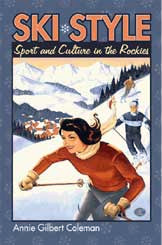Book Review:Ski Style: Sport and Culture in the Rockies |
 |
I often ask myself why I am so obsessed with skiing. Is it the physical act of making turns on a snow-covered slope? The opportunity skiing gives me to experience nature during the winter? The chance to spend some quality time with friends and family? The sport’s fascinating technology, clothing, and gear? A nice meal at a resort restaurant? Or sitting by a warm fire in my ski condo at Timberline watching the snow come down? Annie Gilbert Coleman tries to get to the essence of why Americans love the sport so much in her new cultural history of skiing, Ski Style.
Coleman possesses all the right credentials to be one of the sport’s “deep” thinkers: she grew up in New Hampshire, competed on the U.S. Freestyle Ski Team, earned a Ph.D. in history from the University of Colorado at Boulder, and now teaches history and American studies at Indiana University-Purdue University in Indianapolis, Indiana. As both a “new school” skier and scholar, Coleman has written more than a traditional history of the sport. This is the first book to seriously delve into skiing’s collective beliefs, internal norms, and the underlying practices of the hobby. So what does that mean? It means that Coleman is interested in who skis, why they do it, and how they perceive themselves.
Her approach combines the methods of anthropology, museum studies, sociology, and history, and the book’s sources include ski brochures, interviews, artifacts, old photos, and back issues of Ski Magazine. It’s an avalanche of information, but the material is always well presented and meaningful.
The book begins by digging into the sport’s late 19th and early 20th century roots in Colorado, looking at such pioneers as skiing mailmen, miners, and Norse ski jumpers. She also discusses the significance of ski clubs in developing the sport. Associations like the Colorado Mountain Club not only organized ski trips, but recruited Austrian instructors to teach its members the latest European techniques, and helped cut and maintain trails. Surprisingly, the U.S. Army is partly to blame for the sport’s growth in America. During World War II, it taught an entire division of troops how to ski, and while this division, the 10th Mountain, hardly used its skis in Italy, it veterans returned home with a life-long appreciation for the sport.
Members of the 10th Mountain Division who visited Alpine ski centers in Europe also came home with a determination to develop similar resorts in America and transfer the “the cosmopolitan and social image of European resort culture to Colorado.” This trend continues to the present day at Vail, where visitors can stroll through an ersatz Bavarian Village, eat at an authentic Wienerstube, or ride the Vista Bahn up the mountain.
But other resorts, notably Steamboat Springs, tried to cultivate a uniquely Western chic in their marketing and advertising. In 1970, the resort hired Olympian Billy Kidd (a native of Vermont) to dress up in a Stetson hat and turn the place into the Wild West. According to the author, “Kidd allowed Steamboat to publicize its ranching past and develop its image as a historic and wild cow town, thereby plugging the resort into a long tradition of Wild West iconography that tourists recognized and welcomed.”
As Steamboat and Vail’s quests to become instant tourist attractions illustrate, skiing, for some, is more about style, spectacle, and status than nature, physical experience, and sport. To expand from being an esoteric hobby of a few hundred club members to a sport that now boasts over 57 million skier/snowboarder visits per year, skiing had to become accessible to the masses and also offer activities beyond skiing.
Coleman does an excellent job of explaining the technologies that made skiing easier for average Americans, beginning with the chairlift and ending with shaped skis. She describes how in the early days of skiing, club members lovingly maintained slopes by boot packing runs, and filling sitzmarks where skiers had fallen. As the sport increased in popularity after World War II, people stopped accepting individual responsibility for trail maintenance and slopes started to bump up and become un-skiable for novices. Steve Bradley of Winter Park solved the problem of moguls by designing snow-grooming equipment. Ski Patrol members originally pulled his “Bradley Parker” contraption behind them to smooth snow. Ten years later, Loveland Basin introduced a grooming machine pulled by a snow-cat.
Lifts, as we know, were a critical innovation for the sport, but just as important were Marker safety bindings, plastic boots, and intermediate slopes. Anyone who has skied Vermont knows that the trails developed in the 1930s by ski clubs and the Civilian Conservation Corps tend to be narrow, steep, and filled with difficult terrain features. These trails proved excellent for the tough club skiers who originally enjoyed them but the masses needed easier terrain. After World War II, therefore, resort developers concentrated most of their efforts on developing artificially contoured, intermediate slopes that avoided steep pitches, chutes, cliffs, and other obstacles. With the backhoe, the grooming machine, the chairlift, and snow gun, ski resorts tamed landscapes of rock, snow, and ice for large numbers of novice skiers. The call of the wild, as Coleman put it, became the “call of the mild.”
With the advent of skiing for the masses came other diversions ranging from shopping to restaurants, to warm weather activities such as golf and tennis. Droves of people who had little if any interest in skiing began arriving at ski resorts to soak up the atmosphere and relax in the serenity of the mountains. They appreciated the amenities these resorts had to offer and the glamour of the people who frequented them, especially the movie stars but also the ski bums. Coleman points out that one of the things that made skiing so appealing between 1950 and 1980 was that the person waiting your table generally enjoyed skiing as much as you and probably came from the same socio-economic background. Ski bums gave resorts a campy feel and spared visitors the race and class divides they often experienced dealing with service workers in cities.
Of course, as the sport continued to grow in the 1990s and more and more labor was required to operate resorts like Vail and Aspen, management had difficulty attracting enough bums to run all operations. Increasingly, immigrant workers who have no interest in skiing perform much of the menial labor at resorts while classic “bums” handle more elite jobs such as ski instructor positions, bar tenders, realtors, etc. Coleman laments the fact that the ski industry has done a poor job of attracting minority groups to the sport. For example, while black skiers now spend over $200 million a year on the sport, ski resorts still rarely display African-American skiers in their brochures.
Coleman’s last chapter addresses some of the current pitfalls of the sport. She elaborates on the environmentalist critique that resorts have over-expanded and damaged sensitive wilderness areas. Interestingly enough, however, she’s sympathetic towards the U.S. Forest Service (USFS) in this debate. While the Forest Service certainly encouraged the growth of ski resort development in the years following World War II, since the early 1970s, it has been more of a thorn in the side of the industry than its staunch ally. Resorts must now wait years to secure permits to use Forest Service lands for skiing and these permits are no longer guaranteed. Increasingly, the Forest Service has seen itself more as an arbitrator between the competing interests of ski resorts, local citizens, hunters, loggers, and environmental organizations rather than an unwitting ally of any one particular interest group.
The author is neutral about the future of the sport. “Today a place like Aspen can be simultaneously disgusting and appealing,” she writes. Skiing has certainly evolved well beyond the sport to include almost all aspects of consumer culture, ranging from shopping to real estate ventures. “But we need not lament that Americans care only about image,” she argues. In the end, it is the “combination” of sport and style that makes skiing so interesting and appealing.
John Sherwood is a columnist for DCSki. When he's not hiking, biking, or skiing, he works as an author of books on military history.


Join the conversation by logging in.
Don't have an account? Create one here.